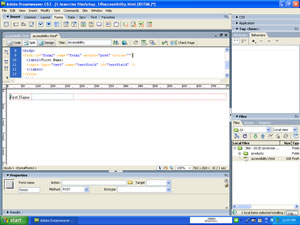When creating websites, one part that should always be taken into consideration is the accessibility of your website. Web Accessibility is how simple the usability of your website is. If you want all of society to be able to use then you need to divide the masses into groups. This way your website wont be intimidating but, instead it will be inviting.
The ADA or Americans with Disabilities Act is the most important aspect of accessibility. This law states that anyone whom is disabled cannot be discriminated against. This law even applies to web sites. How someone who is blind or deaf be able to view your website? In web design there are many ways for the handicapped to web surf.
The first category to focus on is navigation. One rule to always go by is three-click rule. This means grouping similar links into similar categories. If finding a subject takes more than 3 clicks the viewer can become frustrated and travel away from the site. When creating a website keep it simple because all the viewer wants is the information they're looking for. This means dividing links into menus that are easy to understamd. Mastering this is only beneficial.
In America today, 1 in 5 citizens are considered disabled. So, as a web-page designer you have discover ways to help make websites easily accessible for each type of disability. The visually disabled can be the most difficult to design for even though there are many advances in technology. Speech to speech translators, such as a Braille translator can convert text to raised dots. Low vision can be solved with on screen magnifiers to enlarge the page. Physically disabled can use touch screen devices which wont require physical labor. For poor cognitive learners there a 3 things to remember. Keep links simple, use graphics to represent large amounts of text, and make graphics able to turned on or off.
Simply go to File>Check Page>Accessibility. This allows Dreamweaver to analyse your page.
1. Web Accessibility is how simple the usability of your website is.
2.The ADA or Americans with Disabilities Act is the most important aspect of accessibility. This law states that anyone whom is disabled cannot be discriminated against.
3. The ADA applies to web design because using a computer can be limiting to the handicapped. From hearing disabled, to blindness, to physically disabled.
4. Simplifying the content means to present the content in a straightforward and logical order.
5.Simplifying the navigation means having a menu that is easy to read and easy to understand.
6.It should take a minimum of 3 clicks to get from one page to a different page.
7.Such ways to help make your site accessible to the visually impaired are speech-to-speech and braille translators.
8. Text magnifiers and altering colors in the CSS can make your website more accessible for people with low vision and color blindness.
9. If there is audio or video on your site, applying captions of the lyrics can make it entertaining for deafness and hardness of hearing.
10. One way to help people with restricting physical disabilities is providing a laser pointer attached to their glasses which allows them to aim at the screen and select options that way.
11.Keeping navigation simple, using graphics instead of text, and allowing the option to turn audio on and off can benefit people with cognitive disorders.
Accessing Forms can be relatively easy for some but for others it can be a very taunting process. Fortunately, Dreamweaver provides options such as: Wrap with Table tag, and the Access key make accessing forms a breeze.
